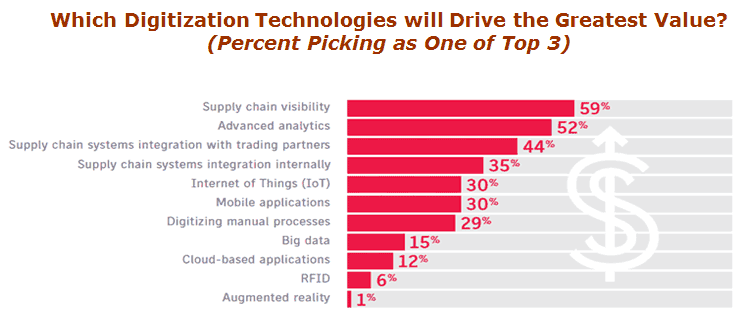A few weeks ago, SCDigest editor Dan Gilmore moderated an outstanding panel discussion at the annual conference of MHI, held for 2016 in the Hilton el Conquistador hotel near Tucson, AZ.
You can find Gilmore's overall review of the conference here: Trip Report - MHI 2016 Conference: Time to Cross the Chasm?
The panel discussion moderated by Gilmore was loosely connected to MHI's upcoming Materials Handling Roadmap, scheduled to be released in 2017. The first Roadmap was released in 2014, and was a solid piece of work, presenting a broad overview of the issues and technologies that will be central to logistics in coming years.
To produce the new report, MHI once again is holding a series of conclaves across the US (four in total) where 40-50 practitioners of all sorts gather for a day and a half to talk through a variety of issues, and that feedback then becomes core content to the final Roadmap.
Supply Chain Digest Says... |
|
|
This year, those discussions are oriented around four main themes: workforce issues, technology, the consumer, and infrastructure - all obviously very big and broad topics.
The conference panel moderated by Gilmore was then also organized along those same four themes. The discussion by the panel was so excellent, SCDigest wanted to report on the conversation in more detail. Given that the full session lasted 90 minutes, we are breaking our summary up, with one article each on the four themes over coming weeks.
Last week, SCDigest detailed the discussion related to workforce (see Detailed Recap of Outstanding MHI Conference Panel - Focus on Workforce). This week, the focus is on the discussion around the very broad subject of supply chain technology.
The panelists at the MHI were: Jonathon Rader, FedEx; Mike Regan, TranzAct Technologies; Bill Ferrell, Clemson University; Fab Brasca, JDA Software; and Mike Kotecki, Dematic, and Gary Forger, MHI.
Gilmore started by sharing some data relative to a study on various digital technologies SCDigest conduted earlier this year in partnership with JDA.
As shown below, the top ranked technology was "supply chain visibility," though Gilmore noted that term means different things to different people.
Visibility was followed by advanced analytics and digital integration with trading partners.

Source: SCDigest and JDA Survey 2016
Gilmore also said he was surprised "augmented reality" scored so low, given it seems to have real applications to improve productivity in order picking and other applications in the DC.
MHI's Forger said that in the first two meetings associated with the new Roadmap, participants indicated they wish vendors would produce technology that could be characterized as a "learning system," meaning that would change on its own as the business changes.
JDA's Brasca said he was not surprised that visibility came out on top of the survey results, saying that there are many other technologies that are related to visibility, such as Internet of Things.
Brasca noted the difference between information and insight when it comes to visibility.
"You have lot look at what's the decision support that goes with that information, where's the intelligence of the system behind that, to deliver something that's actionable," he noted, adding that while the start is to improve managers' ability to make decisions, increasingly the software will deliver the recommended solutions to those managers.
Gilmore noted that Procter & Gamble started promoting the concept of "actionable visibility" more than a decade ago, though what that really means is still evolving in the supply chain. He compared supply chain visibility to an onion, saying you get to one level, but then peel the layer back to get to the next level, and then again, etc., with visibility being more of a journey than a destination.
(See More Below)
|
CATEGORY SPONSOR: SOFTEON |
|
|
| |
|
|
Visibility is tied to the subject of so-called "advanced analytics," and Dematic's Kotecki said that even though he works for a company normally associated with hardware systems for materials handling, the majority of Dematic's R&D investment now is going into software and analytics, though he noted the advances in order picking robots is proceeding rapidly and is likely to really impact DC operations very soon.
"Robotics, with the progress in vision systems and end-effectors cases or items[tools that can grab cases or items], is adancing very rapidly for order picking," Kotecki said, adding that such automation is likely to be one answer to the DC labor shortages issues discussed earlier by the panel, as we summarized last week.
Clemson's Ferrell said he thinks the general trend right now towards "distributed information" to improve local decision-making is likely to reverse, with more data being managed centrally where "algorithms can make the decision," and Gilmore agreed that is where we seem to be heading.
 FedEx's Rader said at this point his company is casting a wide net in terms of evaluating all these new technologies. FedEx's Rader said at this point his company is casting a wide net in terms of evaluating all these new technologies.
"We're not discounting anything yet," Rader said. He said that while FedEx is certainly looking at the potential for autonomous trucks, there are still so many barriers such as safety concerns and the regulatory environment it is impossible to know where this is ultimately headed.
"In some of these areas, like the autonomous trucks, we may not wind up with exactly the technology we are talking about today but some derivative of it," Rader said, adding that in part that is because in some cases there is some "cool" tchnology that can be a solution still looking for a problem to address.
TranzAct's Regan sees a lot of hope for analytics to take waste out of freight transportation. He said some 85% of all US truckload freight moves in the spot market, where shippers basically find a trcuk when they need one.
Why is that percentage so high? Because to most companies, the supply chain looks random and chaotic, Regan said. But technology may allow shippers to take a step back and see patterns that aren't easy to perceive on the surface, and that freight moves are actually more predictable than many shippers realize.
An audience member wondered about the impact on people and maintaining complex systems like robotics or self-driving vehicles - how will companies develop these new capabilities?
There was general agreement by the panel that this is indeed a real issue, though with no obvious answer other than there will have to be an investment in people to run and maintain these advanced technologies - else they cannot succeed.
Regan added that there is a real opportunity to reduce the amount of trucks travelling down the road empty - a true example of waste - through new analytic solutions and Cloud-based visibility.
Brasca concluded the technology discussion by noting a trend in the growth of what he called "micro services," saying that while traditonal supply chain software has been very powerful, it was often too difficult to adapt with the rapid pace of change.
He believes a solution that dilemma could be micro services, which he said are really like apps designed to address a specific problem or opportunity.
"You take what you have already invested in and make it better by plugging in some new capability," Brasca said.
Next week: a summary of the panel discussion around the topic of "the consumer."
What strikes you relative to this discussion of supply chain technology issues? What was left out? Let us know your thoughts at the Feedback section below or the link above to send an email.
Your Comments/Feedback
|